Rotator Cuff Repair
Routine (Early) Rotator Cuff Repair :: Massive (Delayed) Rotator Cuff Repair
Routine (Early) Rotator Cuff Repair
General Instructions for Therapists:
- Therapy is to being 2 weeks after the surgery for this protocol.
- The patient should work with their therapist 1-3X per week until released by the surgeon.
- Do not add or skip any part of this program. If you have concerns please contact my office.
- Your patient has received a home therapy exercise guide. You should review this home exercise program with the patient.
Sling Wear:
- A sling with a small pillow is to be worn for 6 weeks after surgery. Patients must wear their sling at all times for the first 6 weeks after surgery, this does include while they are sleeping. Patients may only remove the sling to perform therapy exercises and for showering.
Ice:
- The use of ice or ice machine is encouraged to help control pain and inflammation after surgery.
Activity Restrictions:
- Showering: 48 hours – once bulky dressing removed
- Deskwork: When comfortable with sling
- Driving: Not until sling is off at 6 weeks
- Using arm for Activities of Daily Living: 6 weeks
- Using arm to reach overhead: 12 weeks
- Using arm to reach behind back: 6 weeks
- Using arm to carry objects: 6 weeks
- Pushing/Pulling: 6 weeks
- Sport/Heavy Activity: When finished with therapy program
Questions/Concerns:
- Therapists – if you have questions or concerns, please contact me directly or contact my office. Email is best for non-urgent issues: Adam.Seidl@ucdenver.edu
Exercise Program
- The exercise program is divided into four time-dependent phases. Do not advance into the next phase until the appropriate time after surgery.
- Exercises should be performed daily supervised by a therapist 1-3X/week, and at home on the other days
PROTOCOL OVERVIEW
All time points are based on time since surgery:
Phase 1: Passive Range of Motion 2-4 Weeks
Passive range of motion begins 2 weeks after surgery. Passive range of motion requires the therapist or an assistant at home to put the arm through a comfortable range of motion while the patient is supine. Motions include: forward elevation, eternal rotation, and abduction – all within a comfortable range. Pendulum exercises are begun during this time. Scapula exercises can be performed while the patient’s arm is in the sling. Scapula exercises should include shrugs, depression, retraction, and protraction. Hand, wrist, and elbow motion should be done ad lib.
Phase 2: Active Assisted Range of Motion 4-8 Weeks
This phase introduces active assisted range of motion. The patient lies supine and uses their other arm (or cane or stick) to move the affected arm into forward elevation, external rotation, and abduction. The patient does this supine at week 4, 45 degrees upright for week 5, and completely upright at week 6. After week 6 the patient can use pulleys for forward elevation.
Phase 3: Active Range of Motion 8-12 Weeks
While continuing to work on active assisted motion, the patient now begins active range of motion in forward elevation, external rotation, and abduction. In addition, isometric strengthening exercises begin at this time.
Phase 4: Resisted Exercise 12-16 Weeks
After 12 weeks the patient can begin strengthening with resisted exercise using an elastic band or hand weights. Scapula muscle strengthening exercises are introduced. Full and Empty-Can exercises are not allowed!
PROTOCOL
PHASE 1 (To start 2 weeks after surgery)
Passive Range of Motion: Motions include forward elevation, external rotation, and abduction – ALL WITHIN A COMFORTABLE RANGE. These exercises are done with each therapy visit – up to 3 times each week.
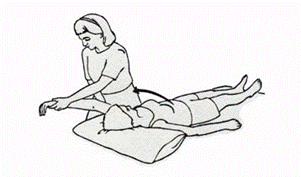
The patient lies supine and relaxes. The therapist will move the arm.
The patient should relax and should not contract any muscles while the therapist moves the arm.
Pendulum Exercises: To be done at therapy session and at home, twice each day. Please insure the patient is doing these correctly, without using the muscles around the shoulder to initiate movement.
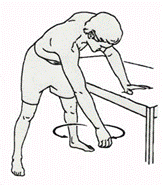
Use torso to move arm by rocking body weight.
Go in clockwise direction then counter clockwise.
Scapula Exercises: Performed while the patient’s arm is in the sling (for first 6 weeks). Scapula exercises should include elevation with shrugs, depression, retraction and protraction. Six weeks after surgery, these can continue out of the sling until strengthening exercises begin, 12 weeks after surgery. These exercises can be done daily.
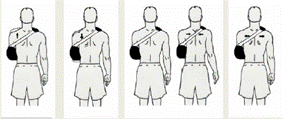
While upright and wearing the sling, bring shoulder blades up as you shrug, down as you depress the shoulder, together toward the spine, and apart. Practice upright posture.

After 6 weeks these same exercises can be done without the sling, with the arm at the side.
PHASE 2 (To start 4 weeks after surgery)
Active Assisted Range of Motion 4-5 Weeks: The 2nd phase of therapy begins with active assisted range of motion and starts 4 weeks after surgery. The patient lies supine and uses the unaffected arm (or a stick or cane) to move the postoperative arm into forward elevation, external rotation, and abduction. These can be done daily.
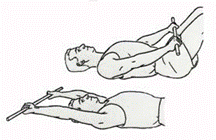
Supine Active Assisted Forward Elevation:
Using a stick or cane, the normal arm will move the affected arm over the head.
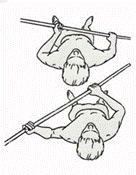
Supine Active Assisted External Rotation:
Keep the affected arm tucked close to the body. Bend the elbow to 90 degrees so the hand is pointed to the ceiling. Using a cane, the healthy arm moves the affected arm in external rotation.
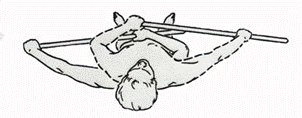
Supine Active Assisted Abduction:
While keeping the elbow of the affected arm straight, the unaffected arm will move the affected arm out to the side of the body as high as is comfortable.
Active Assisted Range of Motion 5-8 Weeks: Five weeks after surgery the patient’s back is propped up approximately 45 degrees and uses the unaffected arm to move the postoperative arm (or a cane or stick) into forward elevation, external rotation, and abduction. After 6 weeks the patient can do these exercises while upright. These exercises can be done daily.
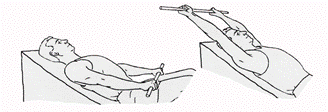
45 Degree Active Assisted Range of Motion:
While propped on a pillow at 45 degrees and using a stick or cane, the normal arm will move the affected arm over the head. The arm is moved in forward elevation, abduction, and external rotation.
This begins 5 weeks after surgery and is done daily.

Upright Active Assisted Range of Motion:
Six weeks after surgery using a stick or cane, the normal arm will move the affected arm in external rotation, abduction, and forward elevation while upright. Sitting in a chair while using pulleys is allowed at this time as well. These exercises should be done daily.
PHASE 3 (To start 8 weeks after surgery)
Active Range of Motion 8-12 Weeks: While continuing to work on active assisted range of motion, the patient now begins active range of motion in forward elevation, external rotation, and abduction. In addition, isometric strengthening exercises begin at this time. These exercises can be done daily.
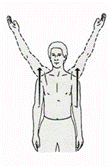
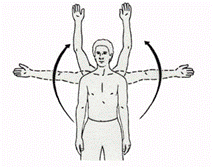
Active Range of Motion: While upright, the patient moves the arm in front of the body (forward elevation) and to the side of the body (abduction)
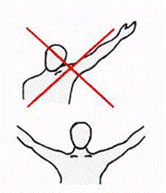
Active Range of Motion: It is important to avoid “hiking” the shoulder. Place the uninvolved hand on the affected shoulder or do these exercises in front of a mirror to avoid this.
Isometric Exercise 8-12 Weeks: Beginning 8 weeks after surgery, the patient can begin isometric exercises. Using a pillow or folded towel the patient applies pressure to the wall without moving the shoulder.
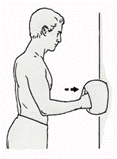
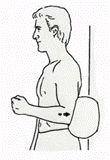
Isometric Push and Pull:
With a pillow against the wall and the arm tucked close to the body, create pressure with the fist for forward push, and with the elbow to push backward. Hold the position for 15 seconds then rest for 30 seconds. Repeat this 10-15 time. This can be done daily.
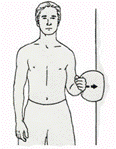

Isometric External and Internal Rotation:
With a pillow agains a wal and the arm tucked close to the body, create pressure with the back of the hand for external rotation, and with the palm of the hand for internal rotation. Hold the position for 15 seconds then rest for 30 seconds. Repeat this 10-15 times. This can be done daily.
PHASE 4 (To start 12 weeks after surgery)
Resisted Exercises 12-16 Weeks: After 12 weeks, the patient can begin strengthening with resisted exercise using elastic bands and/or hand weights. Resisted exercises should be done 3 days per week. Each exercise should be performed as 10-15 repetitions followed by 2 minutes of rest and repeated 3-4 times. These exercises include scapula strengthening and light stretching.

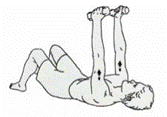


Resisted Scapula Strenthening:
Scapula strengthening exercises include locked elbow extension to work the trapezius, press-up plus reaching toward the ceiling to work the serratus. Rows may be done kneeling with elastic bands, and upright with a hand weight. Like other strengthening exercises, each exercises should be performed as 10-15 repetitions, followed by 2 minutes of rest, and repeated s 3-4 sets. Strengthening exercises should be done 3 days each week.
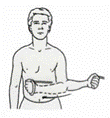
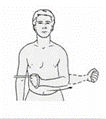
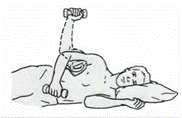
Rotator Cuff Strengthening:
With the arm tucked close to the body, use rubber tubing to provide resistance to internal rotation of the arm. Turn around to use the tubing to provide resistance to external rotation of the arm. Alternatively, you may lie on your side and use small hand weights to provide external resistance. Do 10-15 repetitions, for 3-4 sets, for 3 days/week.
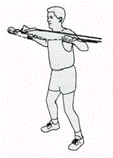
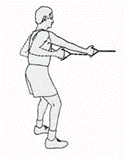
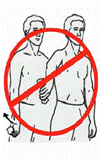
Deltoid Strengthening:
With the arm tucked close to the body, use rubber tubing to provide resistance to forward punches. Turn around to use the tubing to provide resistance to pulling the arm. Do 10-15 repetitions, for 3-4 sets, for 3 days/week.
DO NOT DO FULL OR EMPTY-CAN EXERCISE! These place too much stress on the rotator cuff.


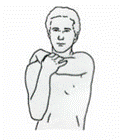
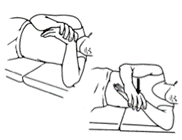
Shoulder Stretching: Stretching should be done daily. Hold each stretch for 15 seconds, rest for 15 seconds, and repeat 5 times. The corner stretch will stretch the anterior shoulder. The towel stretch, cross-body stretch, and the sleeper stretch will stretch the posterior shoulder. Begin with gentle stretching. After 16 weeks, aggressive stretching may be used if needed.
Massive (Delayed) Rotator Cuff Repair
General Instructions for Therapists:
- Therapy is to being 6 weeks after the surgery for this protocol.
- The patient should work with their therapist 1-3X per week until released by the surgeon.
- Do not add or skip any part of this program. If you have concerns please contact me or my office.
- Your patient has received a home therapy exercise guide. THESE BEGIN 6 WEEKS AFTER SURGERY. You should review this home exercise program with the patient.
Sling Wear:
- A sling with a small pillow is to be worn for 6 weeks after surgery. Patients must wear their sling at all times for the first 6 weeks after surgery, this does include while they are sleeping. Patients may only remove the sling to perform therapy exercises and for showering.
Ice:
- The use of ice or ice machine is encouraged to help control pain and inflammation after surgery.
Activity Restrictions:
- Showering: 48 hours – once bulky dressing removed
- Deskwork: When comfortable with sling
- Driving: Not until sling is off at 6 weeks
- Using arm for Activities of Daily Living: 6 weeks
- Using arm to reach overhead: 12 weeks
- Using arm to reach behind back: 6 weeks
- Using arm to carry objects: 6 weeks
- Pushing/Pulling: 6 weeks
- Sport/Heavy Activity: When finished with therapy program
Questions/Concerns:
- Therapists – if you have questions or concerns, please contact me directly or contact my office. Email is best for non-urgent issues: Adam.Seidl@ucdenver.edu
Exercise Program
- The exercise program is divided into four time-dependent phases. Do not advance into the next phase until the appropriate time after surgery.
- Exercises should be performed daily supervised by a therapist 1-3X/week, and at home on the other days
PROTOCOL OVERVIEW
All time points are based on time since surgery:
Phase 1: Passive Range of Motion 6-10 Weeks
Passive range of motion begins 6 weeks after surgery. Passive range of motion requires the therapist or an assistant at home to put the arm through a comfortable range of motion while the patient is supine. Motions include: forward elevation, eternal rotation, and abduction – all within a comfortable range. Pendulum exercises are begun during this time. Scapula exercises can be performed while the patient’s arm is in the sling. Scapula exercises should include shrugs, depression, retraction, and protraction. Hand, wrist, and elbow motion should be done ad lib.
Phase 2: Active Assisted Range of Motion 10-18 Weeks
This phase introduces active assisted range of motion. The patient lies supine and uses their other arm (or cane or stick) to move the affected arm into forward elevation, external rotation, and abduction. The patient does this supine at week 10, 45 degrees upright for week 11, and completely upright at week 12. After week 12 the patient can use pulleys for forward elevation.
Phase 3: Active Range of Motion 14-18 Weeks
While continuing to work on active assisted motion, the patient now begins active range of motion in forward elevation, external rotation, and abduction. In addition, isometric strengthening exercises begin at this time.
Phase 4: Resisted Exercise 18-22 Weeks
After 12 weeks the patient can begin strengthening with resisted exercise using an elastic band or hand weights. Scapula muscle strengthening exercises are introduced. Full and Empty-Can exercises are not allowed!
PROTOCOL
PHASE 1 (To start 6 weeks after surgery)
Passive Range of Motion: Motions include forward elevation, external rotation, and abduction – ALL WITHIN A COMFORTABLE RANGE. These exercises are done with each therapy visit – up to 3 times each week.
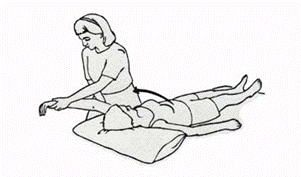
The patient lies supine and relaxes. The therapist will move the arm.
The patient should relax and should not contract any muscles while the therapist moves the arm.
Pendulum Exercises: To be done at therapy session and at home, twice each day. Please insure the patient is doing these correctly, without using the muscles around the shoulder to initiate movement.
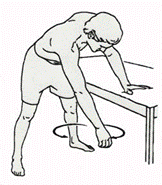
Use torso to move arm by rocking body weight.
Go in clockwise direction then counter clockwise.
Scapula Exercises: Scapula exercises begin after 6 weeks. Scapula exercises should include elevation with shrugs, depression, retraction, and protraction. These are done out of the sling until strengthening exercises begin, 18 weeks after surgery. These exercises can be done daily.

Scapular exercises begin after 6 weeks and are performed out of the sling with the arm at the side. Bring shoulder blades up as you shrug, down as you depress the shoulder, together toward the spine, and apart. Practice upright posture.
PHASE 2 (To start 10 weeks after surgery)
Active Assisted Range of Motion 10-11 Weeks: The 2nd phase of therapy begins with active assisted range of motion and starts 10 weeks after surgery. The patient lies supine and uses the unaffected arm (or a stick or cane) to move the postoperative arm into forward elevation, external rotation, and abduction. These can be done daily.
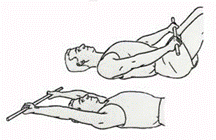
Supine Active Assisted Forward Elevation:
Using a stick or cane, the normal arm will move the affected arm over the head.
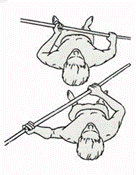
Supine Active Assisted External Rotation:
Keep the affected arm tucked close to the body. Bend the elbow to 90 degrees so the hand is pointed to the ceiling. Using a cane, the healthy arm moves the affected arm in external rotation.
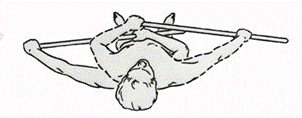
Supine Active Assisted Abduction:
While keeping the elbow of the affected arm straight, the unaffected arm will move the affected arm out to the side of the body as high as is comfortable.
Active Assisted Range of Motion 11-14 Weeks: Eleven weeks after surgery the patient’s back is propped up approximately 45 degrees and uses the unaffected arm to move the postoperative arm (or a cane or stick) into forward elevation, external rotation, and abduction. After 12 weeks the patient can do these exercises while upright. These exercises can be done daily.
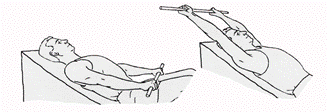
45 Degree Active Assisted Range of Motion:
While propped on a pillow at 45 degrees and using a stick or cane, the normal arm will move the affected arm over the head. The arm is moved in forward elevation, abduction, and external rotation.
This begins 11 weeks after surgery and is done daily.

Upright Active Assisted Range of Motion:
Twelve weeks after surgery using a stick or cane, the normal arm will move the affected arm in external rotation, abduction, and forward elevation while upright. Sitting in a chair while using pulleys is allowed at this time as well. These exercises should be done daily.
PHASE 3 (To start 14 weeks after surgery)
Active Range of Motion 14-18 Weeks: While continuing to work on active assisted range of motion, the patient now begins active range of motion in forward elevation, external rotation, and abduction. In addition, isometric strengthening exercises begin at this time. These exercises can be done daily.
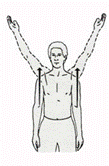
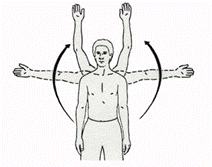
Active Range of Motion: While upright, the patient moves the arm in front of the body (forward elevation) and to the side of the body (abduction)
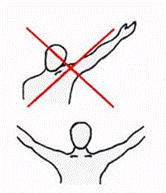
Active Range of Motion: It is important to avoid “hiking” the shoulder. Place the uninvolved hand on the affected shoulder or do these exercises in front of a mirror to avoid this.
Isometric Exercise 14-18 Weeks: Beginning 14 weeks after surgery, the patient can begin isometric exercises. Using a pillow or folded towel the patient applies pressure to the wall without moving the shoulder.
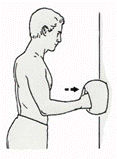
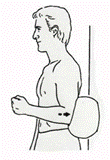
Isometric Push and Pull:
With a pillow against the wall and the arm tucked close to the body, create pressure with the fist for forward push, and with the elbow to push backward. Hold the position for 15 seconds then rest for 30 seconds. Repeat this 10-15 time. This can be done daily.
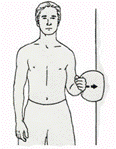

Isometric External and Internal Rotation:
With a pillow agains a wal and the arm tucked close to the body, create pressure with the back of the hand for external rotation, and with the palm of the hand for internal rotation. Hold the position for 15 seconds then rest for 30 seconds. Repeat this 10-15 times. This can be done daily.
PHASE 4 (To start 18 weeks after surgery)
Resisted Exercises 18-22 Weeks: After 18 weeks, the patient can begin strengthening with resisted exercise using elastic bands and/or hand weights. Resisted exercises should be done 3 days per week. Each exercise should be performed as 10-15 repetitions followed by 2 minutes of rest and repeated 3-4 times. These exercises include scapula strengthening and light stretching.

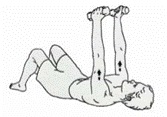


Resisted Scapula Strenthening:
Scapula strengthening exercises include locked elbow extension to work the trapezius, press-up plus reaching toward the ceiling to work the serratus. Rows may be done kneeling with elastic bands, and upright with a hand weight. Like other strengthening exercises, each exercises should be performed as 10-15 repetitions, followed by 2 minutes of rest, and repeated s 3-4 sets. Strengthening exercises should be done 3 days each week.
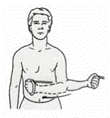
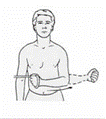
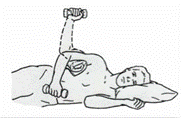
Rotator Cuff Strengthening:
With the arm tucked close to the body, use rubber tubing to provide resistance to internal rotation of the arm. Turn around to use the tubing to provide resistance to external rotation of the arm. Alternatively, you may lie on your side and use small hand weights to provide external resistance. Do 10-15 repetitions, for 3-4 sets, for 3 days/week.
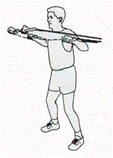
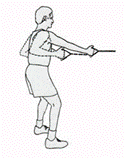
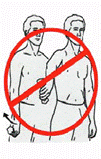
Deltoid Strengthening:
With the arm tucked close to the body, use rubber tubing to provide resistance to forward punches. Turn around to use the tubing to provide resistance to pulling the arm. Do 10-15 repetitions, for 3-4 sets, for 3 days/week.
DO NOT DO FULL OR EMPTY-CAN EXERCISE! These place too much stress on the rotator cuff.


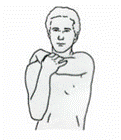
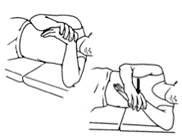
Shoulder Stretching: Stretching should be done daily. Hold each stretch for 15 seconds, rest for 15 seconds, and repeat 5 times. The corner stretch will stretch the anterior shoulder. The towel stretch, cross-body stretch, and the sleeper stretch will stretch the posterior shoulder. Begin with gentle stretching. After 22 weeks, aggressive stretching may be used if needed.
 You will need the Adobe Reader to view and print these documents.
You will need the Adobe Reader to view and print these documents.









